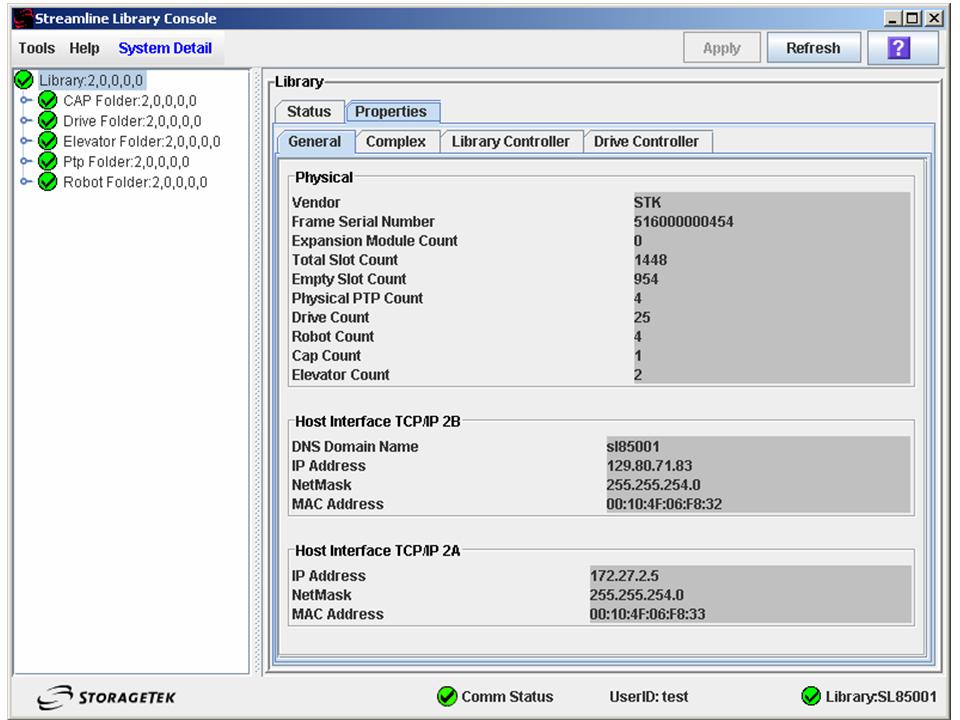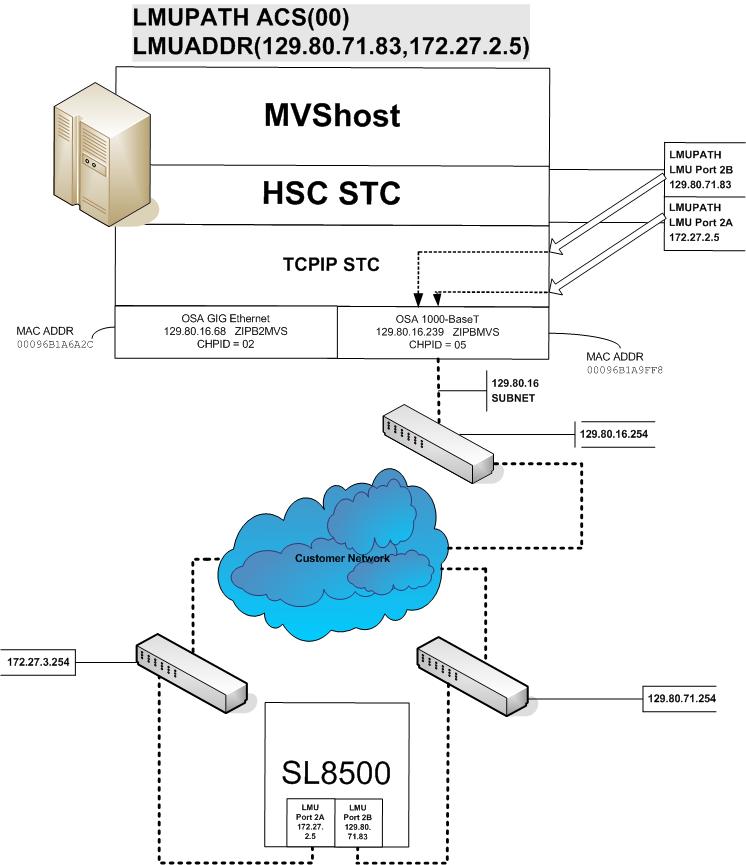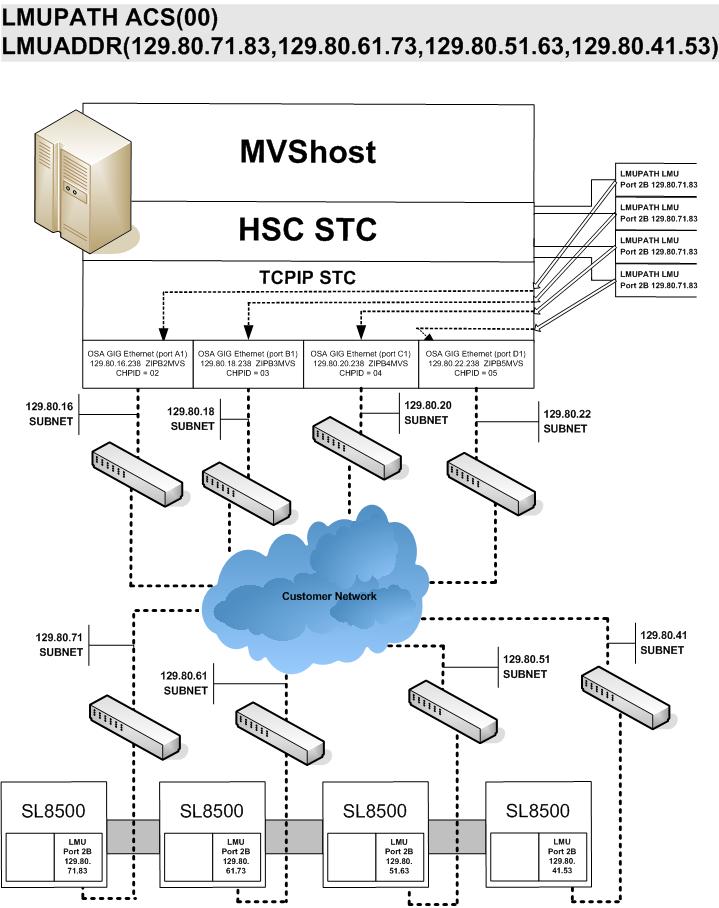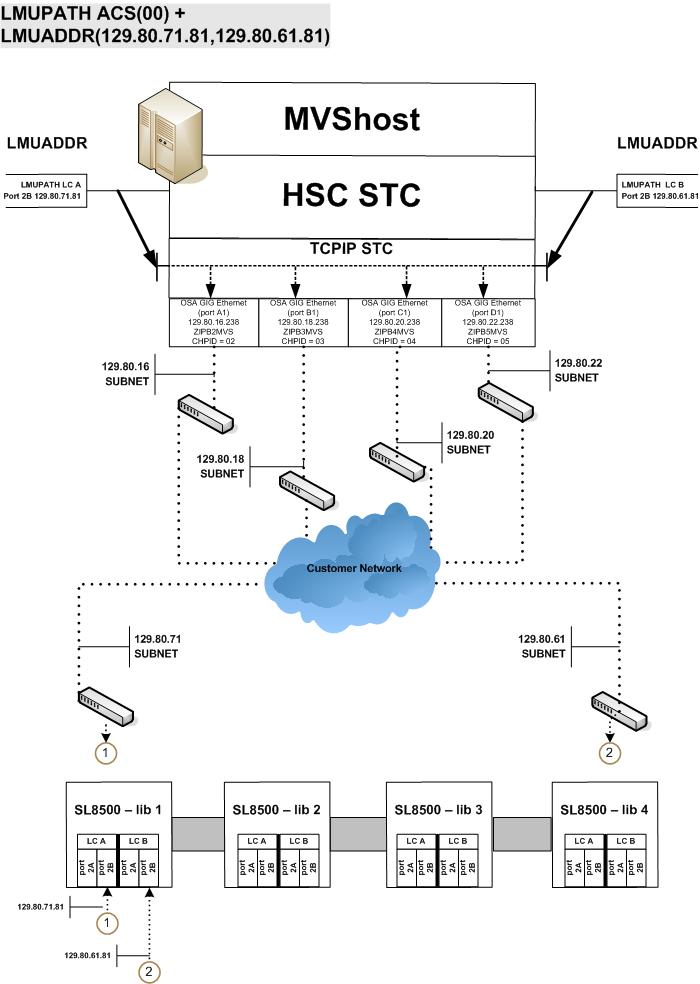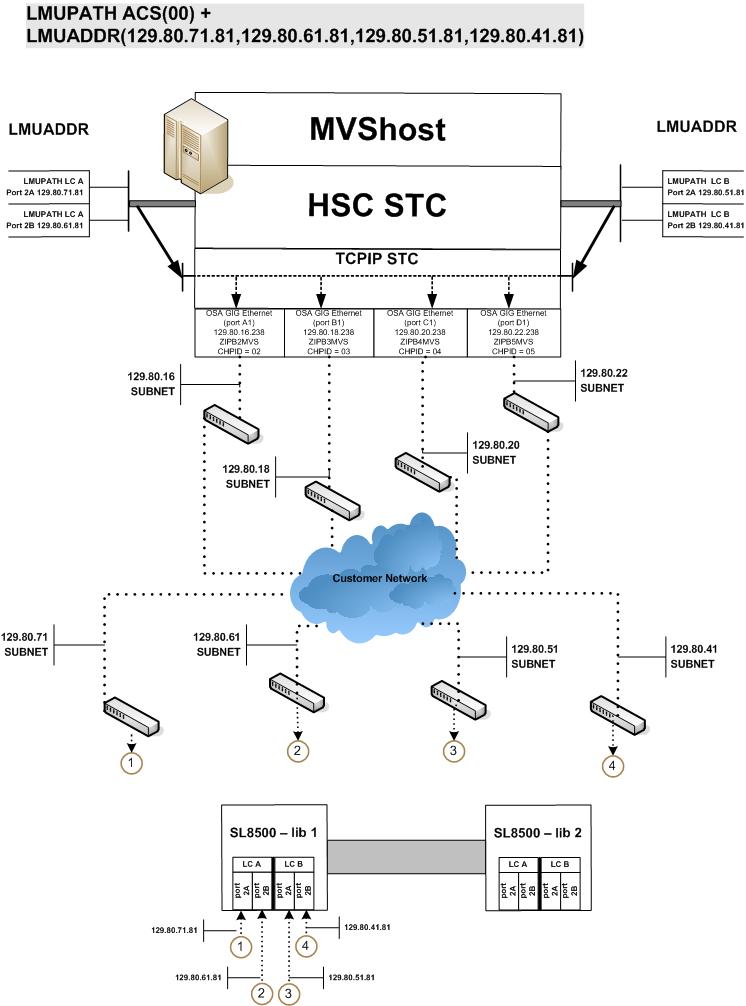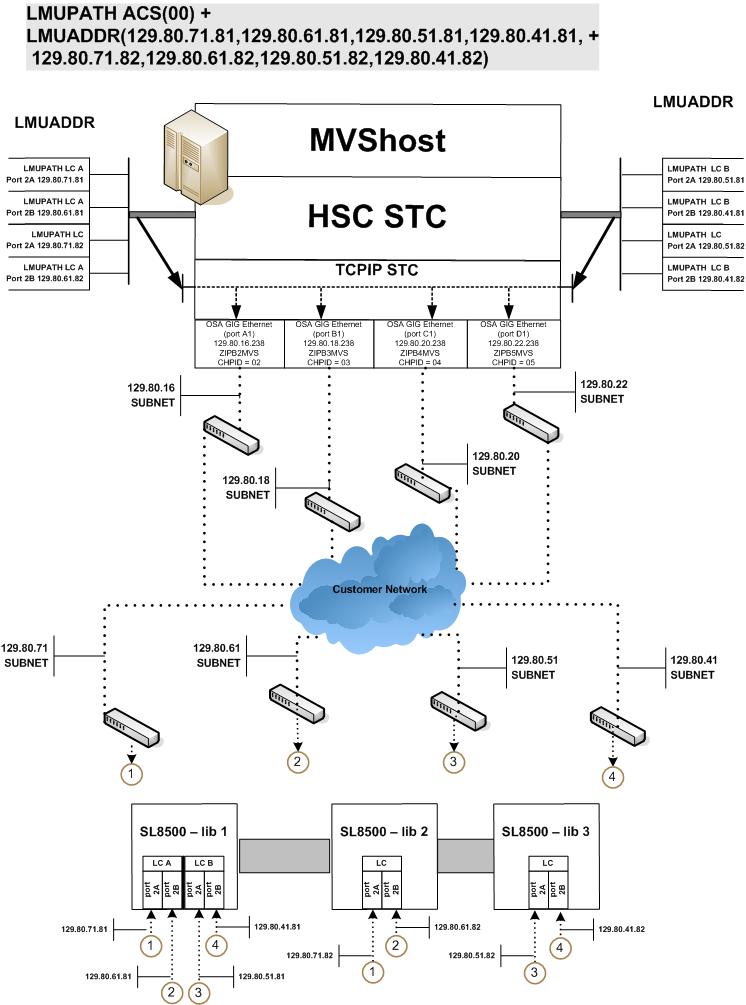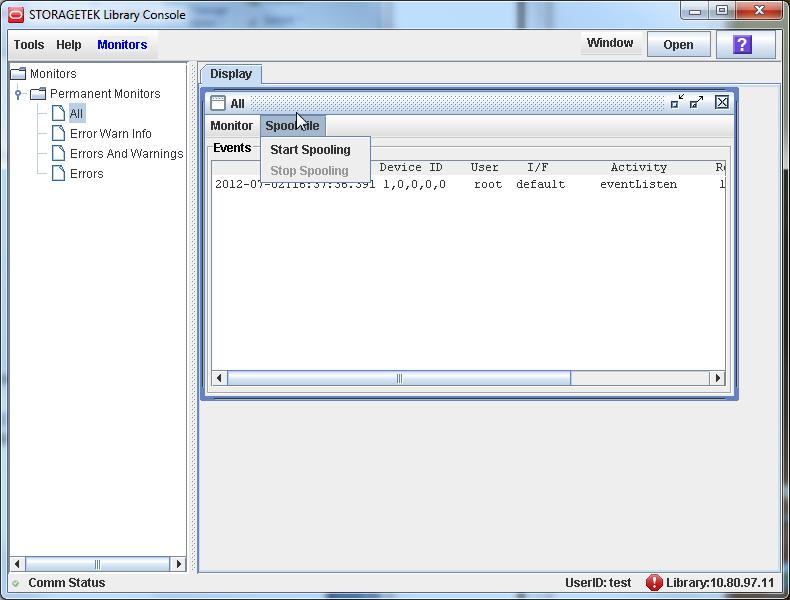D Configuring SL8500 Library Communications
The SL8500 is different from other LSMs, and the way it communicates with HSC is also different, as explained in this appendix.
TCP/IP Communications - Important Considerations
The following topics are discussed here:
SL8500 TCP/IP Connections
When you create an SL8500 library complex by connecting libraries together with passthru ports, all hosts must connect to only one library in the complex— preferably to the first or rightmost library.
For the complex, there are three types of TCP/IP connections for SL8500 discussed in the following sections:
-
"Dual IP Connections" - A redundancy feature to allow up to two connections to the first library of a complex.
-
"Multiple SL8500 Library Connections" - Starting with the SL8500 3.9x firmware release, an SL8500 complex is capable of network connecting up to 4 libraries to HSC. This enhances connecting redundancy to the complex compared to dual TCP/IP.
-
"Multiple TCP/IP Redundant Electronics" - Starting with the SL8500 6.x firmware release, an SL8500 complex is capable of redundant electronics of the library controller with network connecting up to 16 libraries in pairs (one active and one standby) to HSC. This enhances hardware reliability to the complex compared to the other 2 types.
Note:
It is crucial that you read completely these sections to understand these procedures.
Shared Networks
The following are some examples of issues that can arise when you connect an SL8500 to a shared network.
-
A TCP/IP-connected library can handle standard host traffic but it cannot resolve floods of Address Resolution Protocol (ARP) broadcasts. For this reason, it is best to attach the library on a controlled network, such as behind a switch or router.
Later generation networks, such as 1000Base-T and Gig-E, support earlier communication modes; however, devices that are communicating with the library may transmit data at bandwidths that could overwhelm the library.
It is best to attach the library on a controlled network, such as with a switch that can isolate the library from network broadcasts.
-
When you connect the library on shared networks and broadcasts are sent to all network nodes, they may also be directed to the library (even though it does not need them).
During the time the library is receiving these irrelevant broadcasts, it cannot receive from or respond to other requests in a timely fashion. This heavy broadcast traffic on the network can saturate the library to the point that, to the host, it may appear that the TCP/IP connection has been lost. It may also result in Overdue Response Handler (ORH) messages on the host system.
-
Heavy network traffic can also overwhelm the Ethernet controller causing the processor to continuously reset and re-initialize the controller, then recover the host-to-library communications.
Dual IP Connections
The LMUPATH control statement allows users to define network LMU attachments (refer to the ELS Command, Control Statement, and Utility Reference). In a dual IP connection environment for an SL8500, specify a second LMUADDR parameter to define dual IP. HSC automatically determines whether or not the connection is dual IP or dual LMU.
Note:
Vary the ACS offline and back online to pick up the revised LMUPATH statement that includes the second connection.Figure D-1 and Figure D-2 show examples of a dual IP connection for the HSC.
Two SL8500 Network Connections - Two Mainframe IP Addresses
To establish two dedicated routes on different subnetworks from the HSC to two dedicated routes to the SL8500, use the process described in this section. To configure the SL8500 dual TCP/IP feature, refer to StreamLine SL8500 Modular Library System Dual TCP/IP Feature or StreamLine SL3000 Modular Library System Installation Guide.
Figure D-1 shows dual IP connections with two SL8500 network connections.
-
Complete the Network Entries Worksheet (see Table D-1 for a sample) for each set of two dedicated routes to the SL8500. The worksheet can be found in the StreamLine SL8500 Modular Library System Dual TCP/IP Feature document.
-
Define a second DEVICE and LINK statement in your TCP/IP profile data set for a second mainframe network connection.
Example:
; OSA CARD #1 DEVICE ECCQD01 MPCIPA NONROUTER AUTORESTART LINK ZIPBMVS IPAQENET ECCQD01 ; OSA CARD #2 DEVICE ECCQA01 MPCIPA NONROUTER AUTORESTART LINK ZIPB2MVS IPAQENET ECCQA01
-
Define a second home address in your TCP/IP profile data set.
Example:
HOME 129.80.16.239 ZIPBMVS 129.80.65.203 ZIPB2MVS
-
Define a second router on the second subnetwork in the routing paragraph of your TCP/IP profile data set. Remember that you must also configure the SL8500 routing tables according to the instructions described in the StreamLine SL8500 Modular Library System Dual TCP/IP Feature document.
Example:
BEGINROUTES ; NETWORK MASK FIRSTHOP LINKNAME PACKETSIZE ROUTE 129.80.16.0/24 = ZIPBMVS MTU 1492 ROUTE 129.80.65.0/24 = ZIPB2MVS MTU 1492 ROUTE 172.27.2.5 HOST 129.80.16.254 ZIPBMVS MTU 1492 ROUTE 129.80.71.83 HOST 129.80.65.254 ZIPB2MVS MTU 1492 ROUTE DEFAULT 129.80.16.254 ZIPBMVS MTU 1492 ROUTE DEFAULT 129.80.65.254 ZIPB2MVS MTU 1492 ENDROUTES
-
Define two dedicated static routes to the SL8500 destination port (2A and 2B) IP addresses over two different routers.
Example:
; NETWORK MASK ROUTER LINKNAME PACKETSIZE ROUTE Sl8500-port-2A-IP-Address HOST 129.80.16.254 MVSHOST1 MTU 1492 ROUTE Sl8500-port-2B-IP-Address HOST 129.80.64.254 MVSHOST2 MTU 1492 BEGINROUTES ; NETWORK MASK FIRSTHOP LINKNAME PACKETSIZE ROUTE 129.80.16.0/24 = ZIPBMVS MTU 1492 ROUTE 129.80.65.0/24 = ZIPB2MVS MTU 1492 ROUTE 172.27.2.5 HOST 129.80.16.254 ZIPBMVS MTU 1492 ROUTE 129.80.71.83 HOST 129.80.65.254 ZIPB2MVS MTU 1492 ROUTE DEFAULT 129.80.16.254 ZIPBMVS MTU 1492 ROUTE DEFAULT 129.80.65.254 ZIPB2MVS MTU 1492 ENDROUTES
-
Start the second mainframe network connection device.
V TCPIP,tcp-stc-name,START,device_name
-
Define a second LMUADDR parameter for the port 2A IP address on the SL8500.
Example:
LMUPATH ACS(00) LMUADDR(129.80.71.83,172.27.2.5)
-
Enter the LMUPDEF command containing the LMUPATH statements that define the host name or IP address for each ACS.
LMUPDEF DSN(’xxx.xxx.xxx(xxx)')In the following example, LMUPDEF loads LMUPATH parameters from YOUR.DSN(MEMBER)
LMUPDEF DSN(’YOUR.DSN(MEMBER)') -
Allow the trained SL8500 service representative to enter the network connections to the SL8500 library for either port 2A and 2B, whichever is applicable.
-
Vary the ACS offline and back online to pick up the revised LMUPATH statement that includes the second connection. This can be done one host at a time to minimize down time.
Sample Configuration - Two Dedicated Routes
Figure D-2 shows a sample configuration with two dedicated routes, followed by the statements that apply to it.
Setup Statements and Displays
The following information shows the statements and displays used in Figure D-2.
HSC LMUPDEF PARMLIB Member
OPTION TITLE('DUAL TCPIP CONNECTING TO SL8500')
LMUPATH ACS(00) LMUADDR(129.80.71.83,172.27.2.5)
TCP/IP Profile Data Set
; OSA CARD #1 DEVICE ECCQD01 MPCIPA NONROUTER AUTORESTART LINK ZIPBMVS IPAQENET ECCQD01 ; OSA CARD #2 DEVICE ECCQA01 MPCIPA NONROUTER AUTORESTART LINK ZIPB2MVS IPAQENET ECCQA01 HOME 129.80.16.239 ZIPBMVS 129.80.65.203 ZIPB2MVS BEGINROUTES ; NETWORK MASK FIRSTHOP LINKNAME PACKETSIZE ROUTE 129.80.16.0/24 = ZIPBMVS MTU 1492 ROUTE 129.80.65.0/24 = ZIPB2MVS MTU 1492 ROUTE 172.27.2.5 HOST 129.80.16.254 ZIPBMVS MTU 1492 ROUTE 129.80.71.83 HOST 129.80.65.254 ZIPB2MVS MTU 1492 ROUTE DEFAULT 129.80.16.254 ZIPBMVS MTU 1492 ROUTE DEFAULT 129.80.65.254 ZIPB2MVS MTU 1492 ENDROUTES INCLUDE ZIP.TCPIP.PROFILES(COMMON) START ECCQD01 START ECCQA01
TCP/IP Console Displays
D TCPIP,TCPIP,NETSTAT,DEV EZZ2500I NETSTAT CS V1R4 TCPIP 229 DEVNAME: LOOPBACK DEVTYPE: LOOPBACK DEVSTATUS: READY LNKNAME: LOOPBACK LNKTYPE: LOOPBACK LNKSTATUS: READY NETNUM: 0 QUESIZE: 0 BYTESIN: 1781074 BYTESOUT: 1781074 ACTMTU: 65535 BSD ROUTING PARAMETERS: MTU SIZE: 00000 METRIC: 00 DESTADDR: 0.0.0.0 SUBNETMASK: 0.0.0.0 MULTICAST SPECIFIC: MULTICAST CAPABILITY: NO DEVNAME: ECCQD01 DEVTYPE: MPCIPA DEVSTATUS: READY CFGROUTER: NON ACTROUTER: NON LNKNAME: ZIPBMVS LNKTYPE: IPAQENET LNKSTATUS: READY NETNUM: 0 QUESIZE: 0 SPEED: 0000001000 BYTESIN: 34704496 BYTESOUT: 11207410 IPBROADCASTCAPABILITY: NO ARPOFFLOAD: YES ARPOFFLOADINFO: YES ACTMTU: 8992 INBPERF: BALANCED BSD ROUTING PARAMETERS: MTU SIZE: 00000 METRIC: 00 DESTADDR: 0.0.0.0 SUBNETMASK: 255.255.255.0 MULTICAST SPECIFIC: MULTICAST CAPABILITY: YES GROUP REFCNT ----- ------ 224.0.0.1 0000000001 DEVNAME: ECCQA01 DEVTYPE: MPCIPA DEVSTATUS: READY CFGROUTER: NON ACTROUTER: NON LNKNAME: ZIPB2MVS LNKTYPE: IPAQENET LNKSTATUS: READY NETNUM: 0 QUESIZE: 0 SPEED: 0000000100 BYTESIN: 147508801 BYTESOUT: 2188246 IPBROADCASTCAPABILITY: NO ARPOFFLOAD: YES ARPOFFLOADINFO: YES ACTMTU: 1492 INBPERF: BALANCED BSD ROUTING PARAMETERS: MTU SIZE: 00000 METRIC: 00 DESTADDR: 0.0.0.0 SUBNETMASK: 255.255.255.0 MULTICAST SPECIFIC: MULTICAST CAPABILITY: YES GROUP REFCNT ----- ------ 224.0.0.1 0000000001 3 OF 3 RECORDS DISPLAYED D TCPIP,TCPIP,NETSTAT,ROUTE EZZ2500I NETSTAT CS V1R4 TCPIP 250 DESTINATION GATEWAY FLAGS REFCNT INTERFACE DEFAULT 129.80.16.254 UGS 000003 ZIPBMVS DEFAULT 129.80.65.254 UGS 000002 ZIPB2MVS 127.0.0.1 0.0.0.0 UH 000003 LOOPBACK 129.80.16.0 0.0.0.0 US 000002 ZIPBMVS 129.80.16.239 0.0.0.0 UH 000000 ZIPBMVS 129.80.65.0 0.0.0.0 US 000000 ZIPB2MVS 129.80.65.203 0.0.0.0 UH 000000 ZIPB2MVS 129.80.71.83 129.80.65.254 UGHS 000001 ZIPB2MVS 172.27.2.5 129.80.16.254 UGHS 000001 ZIPBMVS 9 OF 9 RECORDS DISPLAYED
HSC Display Showing SL8500 Connection
D ACS SLS0000I D ACS SLS1000I ACS 00 STATUS: CONNECTED 334 ACTIVE QUEUE ELEMENTS 2 COMPATIBILITY LEVELS: HSC=13, LMU=13 DUAL LMU NOT CONFIGURED IP ADDR 129.80.71.83 ONLINE IP ADDR 172.27.2.5 ONLINE SCRATCH VOLUMES AVAILABLE...... 210 FREE CELLS AVAILABLE........... 2008 D TCPIP,TCPIP,NETSTAT,HOME EZZ2500I NETSTAT CS V1R4 TCPIP 252 HOME ADDRESS LIST: ADDRESS LINK FLG 129.80.16.239 ZIPBMVS P 129.80.65.203 ZIPB2MVS 127.0.0.1 LOOPBACK 3 OF 3 RECORDS DISPLAYED
Figure D-3 shows an SLConsole display of ports 2A and 2B, including IP addresses.
Two SL8500 Network Connections - One Mainframe IP Address
To establish one host IP route from the HSC to two routes to the SL8500, use the process described in this section. To configure the SL8500 dual TCP/IP feature, refer to the StreamLine SL8500 Modular Library System Dual TCP/IP Feature document.
Figure D-4 shows dual IP (one host IP) with two SL8500 network connections.
-
Complete the Network Entries Worksheet (see Table D-2 for a sample) for each set of routes to the SL8500. The worksheet can be found in the StreamLine SL8500 Modular Library System Dual TCP/IP Feature document.
-
Define two dedicated static routes to the SL8500 destination port (2A and 2B) IP addresses over one router.
Example:
BEGINROUTES ; DESTINATION FIRSTHOP LINKNAME PACKETSIZE ROUTE 129.80.16.0/24 = &SYSNAME.MVS MTU 1492 ROUTE 172.27.2.5 HOST 129.80.16.254 &SYSNAME.MVS MTU 1492 ROUTE 129.80.71.83 HOST 129.80.16.254 &SYSNAME.MVS MTU 1492 ROUTE DEFAULT 129.80.16.254 &SYSNAME.MVS MTU 1492 ENDROUTES
-
Define a second LMUADDR parameter for the port 2A IP address on the SL8500.
Example:
LMUPATH ACS(00) LMUADDR(129.80.71.83,172.27.2.5)
-
Enter the LMUPDEF command containing the LMUPATH statements that define the host name or IP address for each ACS.
LMUPDEF DSN(’xxx.xxx.xxx(xxx)')In the following example, LMUPDEF loads LMUPATH parameters from YOUR.DSN(MEMBER).
LMUPDEF DSN(’YOUR.DSN(MEMBER)')
-
Allow the trained SL8500 service representative to enter the network connections to the SL8500 library for either port 2A and 2B, whichever is applicable.
-
Vary the ACS offline and back online to pick up the revised LMUPATH statement that includes the second connection. This can be done one host at a time to minimize down time.
Sample Configuration - One Host IP, Two SL8500 Network Connections
Figure D-5 shows a sample dual IP (one host IP) configuration with two SL8500 network connections, followed by the statements that apply to it.
Setup Statements and Displays
The following information shows the statements and displays used in Figure D-5.
HSC LMUPDEF PARMLIB Member
OPTION TITLE('DUAL TCPIP CONNECTING TO SL85001')
LMUPATH ACS(00) LMUADDR(129.80.71.83,172.27.2.5)
TCP/IP Profile Data Set
; OSA CARD #1 DEVICE ECCQD01 MPCIPA NONROUTER AUTORESTART LINK ZIPBMVS IPAQENET ECCQD01 HOME 129.80.&IPADDR1 &SYSNAME.MVS BEGINROUTES ; NETWORK MASK FIRSTHOP LINKNAME PACKETSIZE ROUTE 129.80.16.0/24 = &SYSNAME.MVS MTU 1492 ROUTE 172.27.2.5 HOST 129.80.16.254 &SYSNAME.MVS MTU 1492 ROUTE 129.80.71.83 HOST 129.80.16.254 &SYSNAME.MVS MTU 1492 ROUTE DEFAULT ENDROUTES INCLUDE ZIP.TCPIP.PROFILES(COMMON) START ECCQD01
TCP/IP Console Displays
D TCPIP,,N,DEV EZZ2500I NETSTAT CS V1R4 TCPIP 931 DEVNAME: LOOPBACK DEVTYPE: LOOPBACK DEVSTATUS: READY LNKNAME: LOOPBACK LNKTYPE: LOOPBACK LNKSTATUS: READY NETNUM: 0 QUESIZE: 0 BYTESIN: 2136824 BYTESOUT: 2136824 ACTMTU: 65535 BSD ROUTING PARAMETERS: MTU SIZE: 00000 METRIC: 00 DESTADDR: 0.0.0.0 SUBNETMASK: 0.0.0.0 MULTICAST SPECIFIC: MULTICAST CAPABILITY: NO DEVNAME: ECCQD01 DEVTYPE: MPCIPA DEVSTATUS: READY CFGROUTER: NON ACTROUTER: NON LNKNAME: ZIPBMVS LNKTYPE: IPAQENET LNKSTATUS: READY BYTESIN: 48605838 BYTESOUT: 9790950 NETNUM: 0 QUESIZE: 0 SPEED: 0000001000 IPBROADCASTCAPABILITY: NO ARPOFFLOAD: YES ARPOFFLOADINFO: YES ACTMTU: 8992 INBPERF: BALANCED BSD ROUTING PARAMETERS: MTU SIZE: 00000 METRIC: 00 DESTADDR: 0.0.0.0 SUBNETMASK: 255.255.255.0 MULTICAST SPECIFIC: MULTICAST CAPABILITY: YES GROUP REFCNT ----- ------ 2 OF 2 RECORDS DISPLAYED D TCPIP,,N,ROUTE EZZ2500I NETSTAT CS V1R4 TCPIP 933 DESTINATION GATEWAY FLAGS REFCNT INTERFACE DEFAULT 129.80.16.254 UGS 000001 ZIPBMVS 127.0.0.1 0.0.0.0 UH 000004 LOOPBACK 129.80.16.0 0.0.0.0 US 000000 ZIPBMVS 129.80.16.239 0.0.0.0 UH 000000 ZIPBMVS 129.80.71.83 129.80.16.254 UGHS 000001 ZIPBMVS 172.27.2.5 129.80.16.254 UGHS 000001 ZIPBMVS 6 OF 6 RECORDS DISPLAYED D TCPIP,,N,HOME EZZ2500I NETSTAT CS V1R4 TCPIP 935 HOME ADDRESS LIST: ADDRESS LINK FLG 129.80.16.239 ZIPBMVS P 127.0.0.1 LOOPBACK 2 OF 2 RECORDS DISPLAYED
HSC Display Showing SL8500 Connection
D ACS SLS0000I D ACS SLS1000I ACS 00 STATUS: CONNECTED 942 ACTIVE QUEUE ELEMENTS 1 COMPATIBILITY LEVELS: HSC=13, LMU=13 DUAL LMU NOT CONFIGURED IP ADDR 129.80.71.83 ONLINE IP ADDR 172.27.2.5 ONLINE SCRATCH VOLUMES AVAILABLE...... 210 FREE CELLS AVAILABLE........... 2007
Figure D-6 shows an SLConsole display of ports 2A and 2B, including IP addresses.
Multiple SL8500 Library Connections
This section discusses the following:
Connecting to Multiple SL8500 Libraries in an ACS
When SL8500 3.9x or higher firmware is installed, the HSC can connect to more than one SL8500 in an ACS (library complex).
The HSC supports up to four connections to an ACS. Some possible connections are:
-
four connections to four SL8500s
-
two connections to each of two SL8500s
-
two connections to one SL8500 and two connections to two other SL8500s.
When the HSC establishes two connections to one SL8500, the HSC provides dual TCP/IP or multiple TCP/IP connectivity. Refer to the "TCP/IP Communications - Important Considerations" discussion for more information.
Note:
-
To optimize library performance and minimize inter-library communication among SL8500s, connect to the libraries with the most activity. The HSC distributes communications to the libraries evenly.
-
LMUPATH control statements are used to define network LMU attachments.
The following example shows multiple LMUADDR parameters consisting of four IP addresses. In this case, the first, second, third, and fourth IP addresses indicate a TCP/IP connection to each of four separate SL8500 libraries connected in ACS 00:
LMUPATH ACS(00)+ LMUADDR(123.456.789.012,123.456.789.013,123.456.789.014,123.456.789.015)
Sample Configuration - Four SL8500 Network Connections, Four Mainframe IP Addresses
Figure D-7 shows a sample of a four IP (four host IPs) configuration with four SL8500 network connections. This configuration applies to SL8500 3.x or higher firmware.
Powering Down the SL8500 - HSC Requirements
Prior to powering down the SL8500, the HSC requires that the following procedure must be followed:
-
Vary the drives offline at the MVS host level.
-
Modify the LSM(s) offline (see the MODify Command in the ELS Command, Control Statement, and Utility Reference).
For specific information about powering off the SL8500, refer to the SL8500 User's Guide.
Multiple TCP/IP Redundant Electronics
The LMUPATH control statement allows users to define network Library Controller attachments. In a Multiple TCP/IP redundant electronics environment for an SL8500 complex, specify up to 32 network connections using the LMUADDR parameter. When specified, HSC automatically adjusts when Redundant Electronics is installed.
Note:
Vary the ACS offline, updating the LMUPDEF file to accommodate redundant electronics, read the new LMUPDEF file, and vary the ACS back online to pick up the revised LMUPATH statement that includes the added connections.Sample Configuration #1 - One SL8500 Network Single Redundant Pair Connections, Four Mainframe IP Addresses
Figure D-8 shows a sample four IP (four host IPs) configuration with one single redundant pair SL8500 network connections. This configuration applies to SL8500 6.0 or higher firmware.
Sample Configuration #2 - One SL8500 Network Dual Redundant Pair Connections, Four Mainframe IP Addresses
Figure D-9 shows a sample four IP (four host IPs) configuration with one dual redundant pair SL8500 network connections. This configuration applies to SL8500 6.0 or higher firmware.
Sample Configuration #3 - One SL8500 Network Dual Redundant Pair and 2 Dual TCP/IP Connections, Four Mainframe IP Addresses
Figure D-10 shows a sample four IP (four host IPs) configuration with one dual redundant pair SL8500 and two dual TCP/IP network connections. This configuration applies to SL8500 6.0 or higher firmware.
Troubleshooting Library Connectivity Problems
This section covers procedures on helping you to provide important data to Oracle support when Library connectivity problems occur.
Basic Tracing
The following procedure tells how to produce diagnostic data for basic SL3000/SL8500 host connectivity problems.
-
Using the SLConsole, start a monitor trace (select All) and start spooling to an output file as shown in the example in Figure D-11.
-
Update the HSC PARMLIB member (in bold) to add LMU tracing on as shown in the example.
CDSDEF DSN1(HSC1.PRIM),DSN2(HSC1.BKUP),DSN3(HSC1.STDBY) MGMTDEF DSN(HSC.PARMS)COMMP METH VTAMFEAT VSM(ADVMGMT) CAPP 9,01:00:00,AUTO MNTD AUTOCLN(ON) EJCTAUTO(ON) /* turn LMU trace on */ TR LMU
-
Start GTF to trace the HSC job as shown in the JCL example below.
//GTFTEST PROC MEMBER=GTFTST //IEFPROC EXEC PGM=AHLGTF,PARM='MODE=EXT,DEBUG=NO,TIME=YES', // REGION=2880K,ACCT=505341SPKC //IEFRDER DD DSNAME=GTF.OUTPUT,DISP=SHR /* output trace file */ //SYSLIB DD DSNAME=TEST.PARMLIB(&MEMBER),DISP=SHR
Or, use a GTF SYSLIB member as shown in the following example.
TRACE=USR,JOBNAMEP JOBNAME=(HSCT*) /* HSCT* = HSC jobname prefix (jobname example: HSCT1234) */ END
-
After a problem occurs:
-
Stop GTF.
-
Stop the spooling in the monitor trace.
-
Stop HSC.
-
-
Send to the monitor trace, GTF output files, and HSC log to StorageTek/Oracle support.
Packet Tracing
A packet trace, which traces the actual data packets that are being transferred across the line, can be helpful when trying to determine if data is actually being sent across properly. The following procedure tells how to run a packet trace.
-
Create an external writer proc in SYS1.PROCLIB(CTTCP) as shown in the following example.
//CTTCP PROC //CTTCP EXEC PGM=ITTTRCWR //TRCOUT01 DD DSN=Your_data_set,UNIT=SYSDA, // SPACE=(CYL,(100),,CONTIG),DISP=(NEW,CATLG)
-
Enter the following MVS commands:
TRACE CT,WTRSTART=CTTCP TRACE CT,ON,COMP=SYSTCPDA,SUB=(your TCP/IP started task name) R n,WTR=CTTCP,END D TRACE,COMP=SYSTCPDA,SUB=(your TCP/IP started task name)
Note:
This will verify that trace was started successfully.V TCPIP,your TCP/IP started task name,PKT,ON,IP=xx.xx.xx.xx
Where xx.xx.xx.xx is the IP address you want to trace.
-
Run the trace until the error occurs.
-
Enter the following MVS commands:
V TCPIP,your TCP/IP started task name,PKT,OFF TRACE CT,ON,COMP=SYSTCPDA,SUB=(your TCP/IP started task name) R n,WTR=DISCONNECT,END TRACE CT,OFF,COMP=SYSTCPDA,SUB=(your TCP/IP started task name) TRACE CT,WTRSTOP=CTTCP,FLUSH
-
To format the trace, use IPCS and the following command:
CTRACE COMP(SYSTCPDA) FULL
Or use IPCS menu option 2, Option 7, Option 1, Option D and then enter component name SYSTCPDA and report type FULL.

